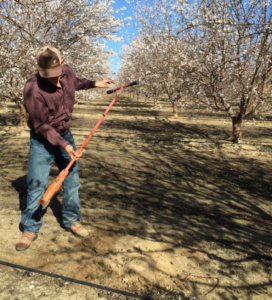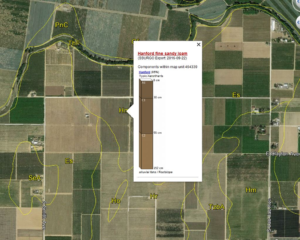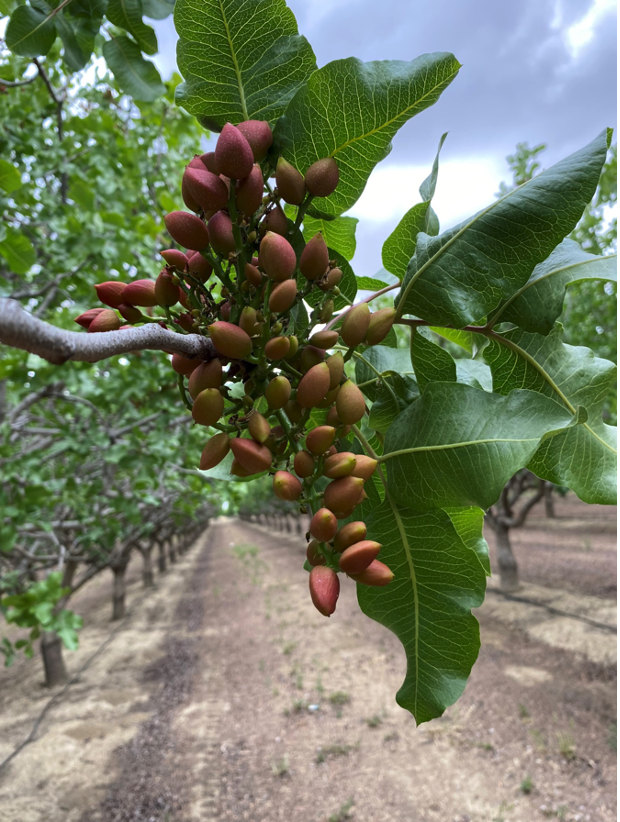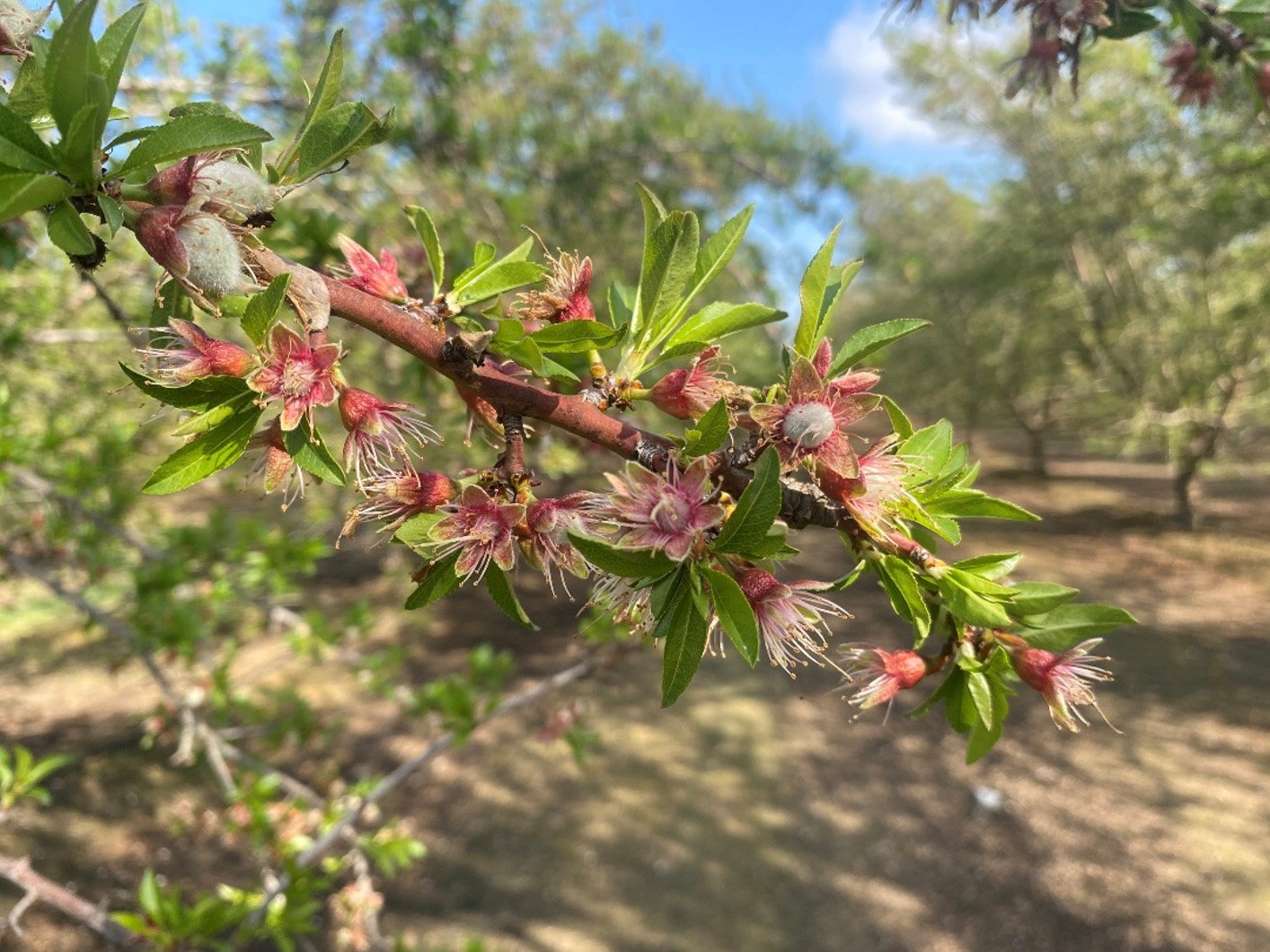
It is that time of year where the heat turns up and crops begin pumping water out at an ever-increasing rate. Some, too many, decide that watering unto 12-18 inches will suffice for keeping the plant healthy and delivering enough water for maximum plant growth.
Others are so possessive of their deep moisture that they will keep the irrigation water flowing until their drive rows are more algae than bare dirt and all the gophers pull up stakes on their flooded homes and move to the neighbor’s field. All the while, the fully saturated soil under the trees is so anoxic (lacking oxygen) that the root hairs die off and fungal diseases begin to attack the oxygen starved root wood.
 This isn’t to poke fun at anyone. These are real difficulties that can be tremendously frustrating, and sometimes nearly impossible to work through, especially without the use of real-time tension readings. There is hope however! It is absolutely possible to rehydrate extremely dry soils even during periods of high-water use, and even with difficult soils. More on that further down.
This isn’t to poke fun at anyone. These are real difficulties that can be tremendously frustrating, and sometimes nearly impossible to work through, especially without the use of real-time tension readings. There is hope however! It is absolutely possible to rehydrate extremely dry soils even during periods of high-water use, and even with difficult soils. More on that further down.
Irrigation through the summer months is so much easier if you never let things dry out too much in the first place. Soils are kind of finicky. They like things to be just right, especially if they have any significant amount of clay in their texture.
I used to think that the drier a soil, the “thirstier” it was, and so the more readily it would allow water to infiltrate. However, I have discovered the opposite to be true. Soils are a complicated mix of molecules, layers, layers within layers, organic matter, microorganisms, and minerals. All of these components interact with each other in chemical and physical ways that influence the way water is adsorbed by the soil. The resulting effect is that soils that have become extremely dry do not readily take in water. To a great degree, dry soils become hydrophobic. When water makes contact with a dry soil, it must dissolve salts and minerals, expand clay particles, and create new physical pathways into the soil before the water itself can enter the soil pores. All of this change takes time. And so, we find that rehydrating dry soils takes time.
Dry soils can easily be overwhelmed by quantities of water and will easily begin to slough water off the surface, resulting in runoff and ponding. At the opposite end of the spectrum, very wet soils do not like to take in water either. If you look at a chart demonstrating the hydraulic conductivity (Ksat or infiltration rate) of a soil, you will notice that the more wet a soil is, the more slowly it takes in water. This is pretty clearly due to the physical property of soils, specifically clay in soils. Clay particles are shaped as flakes, teeny tiny flakes made out of layers of changing materials. When the soil is dry, the individual clay flakes nestle together. Nothing holds them apart. But as water is added, water molecules sneak in between the flakes and begin to push them apart, thus making the soil expand. By the time a soil reaches saturation, the clay flakes are expanded so large that the pathways previously used by water entering the soil are almost completely cut off, and severely limit the quantity of water that can enter the soil, thus limiting the infiltration rate. Essentially, hydrated soils become “sealed” off to additional water.
So, both ends of the soil hydration spectrum limits how quickly water is allowed to enter into a soil. Thankfully, there is a happy place in the middle that readily accepts water. When a soil is in this state, I like to call it a “hydrated soil.” In this case, there is enough moisture that minerals and other soil constituents are dissolved or suspended in the soil water, and the clay particles are expanded enough to hold a good structure that allows for a good flow of water through the soil, but it is not so hydrated that it is sealed off. It is the perfect state where water is easily adsorbed and transmitted throughout the soil.

Soil Hydration Spectrum
Thankfully, this happy, hydrated state tends to correlate very well with the comfort zone for most crops in most soils. It is nice when everything lines up that way! The takeaway here is that: what is good for the plant is good for soil infiltration as well. The better you can manage irrigation to keep the soil tension in the comfort zone for your crop, the easier it will be to get water to infiltrate deep into the soil. In very general terms, the best infiltration tends to occur between 10kPa and 50kPa.
That’s the easy part, prevention. Understanding your soil and how to react to tension data, you change the way you irrigate and keep the soil from ever getting overly dry. However, Murphy’s Law is always at play and sometimes we lose control. Generally, I see three causes of loss of deep moisture:
Equipment Trouble: Plugged pumps, well issues, leaks in pipes, a myriad of issues can occur, and they tend to occur at critical times when the system is being used the most. Sometimes, repair just can’t happen quickly enough and as a result the field will dry out.
- Cultural Practices: Weeds have to be sprayed, pests have to be controlled, downed trees have to be removed. Sometimes all this activity just can’t be coordinated better and things get out-of-hand.
- Misunderstanding of how much water is required: Soils depleted of moisture and high plant demands mean that A LOT of water must be applied to rehydrate a soil and provide for the plant’s needs. What may seem like a lot of water may not even scratch the surface of what is needed.
Regardless of the cause, it happens. And it usually happens during critical periods of crop development and preparation for the following season. So, instead of just giving into it lets figure out what needs to be done to fix the problem so that you can maximize your crop potential.
There are three factors we need to consider when figuring out how to rehydrate a depleted soil:
- What is the application rate of the irrigation system?
- What is the soil’s water holding capacity?
- How much water is the crop using each week?
Let’s walk through these one by one.
Application Rate
Time to break out the math skills. Even if they are a little rusty, this won’t be too hard to figure out. And if you still have the original design of the irrigation system, it may be listed in the drawings. If worse comes to worst, call your local Irrigation Management Advisor or Sales Rep and they can help you calculate the rate. Describing how to determine the rate step by step is a topic for another day and another time. Still, most systems are designed quite similarly. So, we can use a rule of thumb for our purpose today. In general, a double-line drip system puts out 0.02 inches of water per hour, while the standard Fan-Jet system puts out 0.05 inches per hour. For my example today, we will use the rate for a double-line drip system.
Soil Water Holding Capacity
 This can easily be found on soil databases, such as the NRCS’s Web Soil Survey. Personally, I prefer the Google Earth SoilWeb Earth, it is much faster to use and very intuitive. After downloading the KML file for SoilWeb Earth, simply search for the field in question using Google Earth. As the page loads, the different soils in the area will appear on the image. A window will pop up when you click on the soil in your field. The uppermost text in that box is a link to the data for that soil series. Click the link.
This can easily be found on soil databases, such as the NRCS’s Web Soil Survey. Personally, I prefer the Google Earth SoilWeb Earth, it is much faster to use and very intuitive. After downloading the KML file for SoilWeb Earth, simply search for the field in question using Google Earth. As the page loads, the different soils in the area will appear on the image. A window will pop up when you click on the soil in your field. The uppermost text in that box is a link to the data for that soil series. Click the link.
That link will pull up the data you need.

Circled in yellow, the available water storage is listed. Note that the available water storage on this particular soil is 13 centimeters of water per 100 centimeters of soil. Upon converting this via Google we find that it is equal to 5.12 inches of water per 3.28 feet. If we divide 5.12 by 3.28 we find that this soil holds 1.56 inches of water per foot of soil. I have found that although this number is accepted by the scientific community, it isn’t practical for use here. Read the blog, “Using Soil Tension to Measure Key States of Soil Moisture” to learn more about that. For determining how to rehydrate depleted soil, I use just half of what the soil data lists. In this case, that would be 0.78 inches of water. That is to say that a depleted soil will need to have 0.78 inches of water per foot of root zone infiltrate into the soil in order to refill the profile. In this case, I will assume we are working with a permanent crop that needs to have moisture managed down to 3 feet. So, 0.78 x 3 = 2.34 inches.
Now we have two of the needed components, the application rate and the soil’s water holding capacity. Let’s get the next component.
Crop water use
This will be the easiest number to figure out. Most crops have some sort of water usage listed as historic Et. For our purpose today, we are just looking to figure out how long we need to irrigate to supply plant needs and refill the soil profile. Historic Et is useful for that purpose. There are a lot of good resources for historic Et. Check your local Extension service or crop organization for the info. For California crops, here is a pretty good resource: UC Drought Management.
Another useful site to figure out past ET data is found in the link below: https://cimis.water.ca.gov/WSNReportCriteria.aspx CIMIS stands for California Irrigation Management Information System and can be used as a tool to find complete weather data all over California.
Use these resources to determine historic Et for the current week. For almonds near Madera, Calif., the Et for the beginning of July is 1.96 inches per week. That means a mature almond orchard will transpire almost 2 inches of water per week.
Now, we have all three components to determine how long we need to irrigate to rehydrate a depleted soil. Let’s put it all together now.
Bringing it all together
From here the math is pretty simple. We just need to use the numbers above (0.02 inches applied per hour, 2.34-inch water holding capacity, and 1.96 inches Et per week) to figure out how long we need to irrigate in order to rehydrate the soil.
Here we go:
- Total water needed = 1.96 + 2.34 = 4.30 inches
- Hours of irrigation = 4.30 / 0.02 = 215 hours
There you go. In order to rehydrate this depleted soil with this irrigation system, 215 hours of water will be needed to be applied in one week. Simple …
“How on earth am I going to apply 215 hours of water in one week?!” Well you aren’t. Simply because there are only 168 hours in a week. This doesn’t always happen, some soils and some irrigation systems match up in a way that make it so everything can be replenished within one week. But it is just as common to not be able to accomplish it in a single week. When this happens, I extend my plan out over two or three weeks. All you have to do is add another week’s worth of Et for each week you extend it out. In this case, let’s extend it out to three weeks. Now our equation would look like this:
- Total Water Needed = 3 * (1.96) + 2.34 = 8.22 inches
- Hours of Irrigation = 8.22 / 0.02 = 411 hours
Now what we find is that we need to apply 411 hours over the course of three weeks. That is 137 hours per week. That is still pretty hard to accomplish (I made a worst case scenario here), but it is feasible. The best part of this exercise is how well it demonstrates how much water needs to be applied to rehydrate a soil. Many people get frustrated after applying 70 hours within one week. But, a depleted soil can take much more water than that to rehydrate the profile. As a very rough rule, I recommend applying 100 hours of water per week in a depleted soil for as many weeks as it takes to get the profile refilled.
One more consideration
This works. I have accomplished rehydration of soils many times. But it takes a lot of patience. Unfortunately, it isn’t as simple as just turning on the water for 100 hours straight and then shutting it off until next week. At the beginning of this article, I mentioned that both dry soils and saturated soils do not like to let water infiltrate. Very often when rehydrating a soil, the soil resists water infiltration because it is dry, but the conditions quickly turn from too dry to too wet and suddenly the soil doesn’t want to take in the water because the top several inches are saturated. Rehydrating a depleted soil takes some extra TLC. But it is worth it. It is important to be out at the field and to examine the conditions. Let the water run for as long as the soil will take it, but as soon as you are getting ponding or run off, shut it off and give it a break. The soil needs time to allow the water to open it up and move through it, making room for more water. In general, a 12-hour rest is sufficient. Although a little longer is okay. After the rest, turn on the water again and let it run until it begins to pond again. Little by little, you will make up lost ground and the soil will become more receptive as it becomes hydrated to deeper and deeper depths. The most important thing here is that you do not let the field rest too long before coming back with water. If a crop uses 1.96 inches of water per week, that means it is using 0.28 inches of water per day! With an application rate of 0.02 inches per hour you can only apply 0.48 inches of water in a day. If you run the water for 24 hours, the tree uses half of the water you apply while you are applying it, the next half could be used up in the next 24 hours. So, don’t rest it too long before coming back with more. Rehydrating a depleted soil is intensive, but it is the best thing to do for the crop. And it is totally possible.
If all this info makes your head spin, remember the real moral to this story is don’t let your soils get too dry. And if they get dry the earlier you fix it the easier it will be to fix. Don’t worry about it. There is a lot to farming, and a lot to irrigation. Hortau Grower Support Specialists are all trained to help through difficult situations such as this. Give them a call and they will help you figure out the solution to your system.







